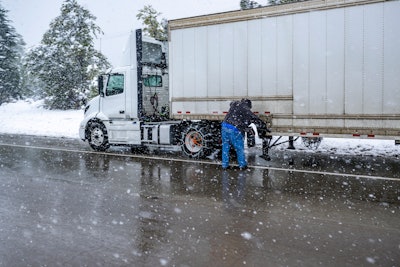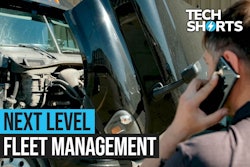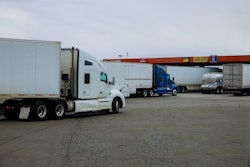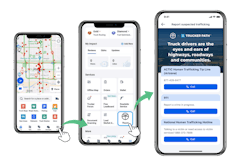
A group of industry experts gathered for a panel discussion regarding fleet management during inclement weather at this year's American Trucking Association (ATA) conference in Nashville, Tennessee.
Extreme weather is nothing new but as the effects of climate change continue to wreak havoc across vast parts of the country, fleets need to take a series of precautions and know how to make the right decisions. The back-to-back hurricanes that struck Florida and the surrounding states earlier this month cannot be ignored, the panelists made clear.
Along with moderator Jeff Martin, VP of global sales strategy at Lytx, panel participants included:
- Mike Palaez - VP of safety and compliance, Airgas
- Dr. Mark Manera - founder and CEO, Offshift and PhD in Physical Therapy
- Pete Palcyznski - pro driver, America's road team captain, Walmart Transportation
"We have a responsibility to safeguard truck drivers and passenger vehicle drivers," Martin said in his opening remarks. "We want to address how are seasoned fleet pros using new programs to manage safety of vehicles and drivers when bad weather hits."
Necessary preparations
When bad weather impacts operations, safety, and customer service, Palaez said that "preparation is key. It's all types of weather. Hot, cold, hurricanes. We need to have procedures in place ahead of time." His driving record speaks for itself: 38 years of experience and 2.8 million safe miles.
Drivers need to do the same as the stakes are much higher compared to that of a dispatcher, for example.
"Depending on weather severity, operations can come to a complete halt due to road closures or bad accidents," Palcyznski added. "I don't have any control over other vehicles on the road. All-wheel drive vehicles could make drivers complacent, because they think they're invincible. When you're going 20 mph on a snow-covered road, AWD won't make the road any safer."
According to official data, of the roughly 5.8 million vehicle crashes each year, approximately 21 percent are related to adverse weather. Major companies, including Walmart, are keenly aware of this.
"Walmart has an emergency operations center. I felt like I was in NASA. It blew my mind about its capabilities," said Palcyznski. He cited an instance from a couple of years ago in Chicago while driving on I-55 before turning on to route 53 where he drove into a wall.
"There was a snowstorm for a mile and a half and it completely shut things down. I was legally out of hours so someone else had to drive my truck back. Things change instantaneously. Such as wind, which you can't see. You feel that in a truck just sitting in the driver's seat."
What are the best practices for those types of conditions?
According to Palaez, "culture is the root of everything. Use the judgement of the driver. There's no amount of money we need to make. Just stop or take it slow and we'll handle the customer later. [It's important for companies] to let drivers know they're invested in them. Communication and culture of letting your people know you care is vital. One example is to ensure all drivers get snow cleats, especially for drivers from the South."
Drivers need to get into a routine of making the necessary preparations for potentially bad weather before they set off.
"I can be in North Dakota one day and south Kansas the next. You've got to be prepared with the assets a company gives you, so I'm prepared for anything. If I have to stop, there's no questions ask," said Palcyznski.
Adverse weather can take up to 5 percent of total truck driving hours, translating to about 32 billion in lost vehicle hours and billions of dollars in added costs.
Walk like a penguin
Drivers need to take necessary precautions outside of the cab as well, especially during snow and ice storms. If they can avoid leaving their vehicles, they should.
"There are times I won't even get out of the truck because it's so dangerous. Even though truck steps are grated, there's still snow and ice build up," said Palcyznski. "If I found myself in a position where I need to pull off the road and stop, I won't even get out of the truck. The penguin walk is just common sense."
Over 70 percent of U.S. roads are located in regions that receive more than five inches of snow annually.
Dr. Manera, who started Offshift after treating truck drivers suffering from back pain, advised drivers to "take a breath, slow down, stay in this moment, and don't worry about being late to maximize miles. This stops a lot of falls coming out of the trailer."
Further data provided by Lytx states that an estimated 23 percent of all roadway delays and 1.2 million crashes annually can be attributed to harsh weather.
Good physical shape
Martin asked the panel what they think a company can be doing to ensure drivers are in ideal physical shape to handle harsh weather, including extreme heat.
Dr. Manera points to research showing that one-third of all muscular skeleton injuries could have been avoided with routine physical activity. Even something as simple as going for regular walks matters.
"It shows the impact that getting drivers moving on a more recurring basis makes a difference. What we're seeing is a ton of stuff for safety procedures, but when it comes to some of the health benefits, preparation is key. Companies are offering drivers specific health programs, such as weight loss, that their health insurance provider put into place," he told the audience. "In one company I spoke to, only three people took part [in a health program] so marketing and communications is important. Find a culture that fits drivers' lifestyle. More forward-thinking fleets are doing this. How are you speaking to your drivers? Are these programs for them or to them? This makes a big difference. A lot of times companies try to rush these programs out and often forget how they're positioning these programs for their respective teams."
Additional things such as promoting more nutritious food and providing meal plans also help. Showing drivers how to use their truck as stretching equipment shouldn't be out of the question. Even just walking around the vehicle to get some exercise at a rest stop has proven beneficial.
Troublingly, the average life expectance of a commercial truck driver is just 61 years. That is 16 years lower than the national average, making truck driving one of the unhealthiest occupations in the U.S.
Palcyznski, for example, said he takes a walk every morning and exercises during the day. He also avoids fast food thanks to his wife packing him homemade meals.
The bottom line for fleets is how can they get drivers healthier for better results.
Safety systems
The value fleets will gain by taking advantage of technologies, such as video and telematics, to stay ahead of the weather is vital. Lytx, for example, is able to provide drivers with instant alerts indicating incoming harsh weather. Modern trucks are already equipped with tools that make drivers' jobs much safer, specifically adaptive cruise control and lane departure warning.
"The tools I have make my job so much safer because of that technology," Palcyznski noted.
Drivers must continue protecting themselves from motorists who could strike them in a red zone, like off ramps. For drivers like Palcyznski, always keeping a space cushion is a must.
"I keep my following distance and the truck's technology will give me the necessary alerts. These technologies do make my job easier but you still have to watch 360 degrees all of the time, including having your mirrors adjusted. If you can see me in my mirror, then I can see you."
Palaez's idea of driver safety goes a step further.
"We don't drivers on the side of the road for obvious reasons. It's a situation you don't want to have. Plan your days. Make sure you have the hours available. The big thing is working with the fleet managers to get safety involved. Do we sit you on the side of the road or run you over hours to get you parked in a safe spot? It's not a pleasant experience."
Truck drivers are 11 times more likely to die on the job than the average worker due to road accidents and even cardiac events.
Going nuclear
The panel wrapped up with a discussion about the recent nuclear verdicts currently hitting a concerned industry. The panels' consensus agreement: motorists are crazy post-pandemic so truck drivers need to be more careful than ever.
"Our challenge is make our drivers better than everyone else," Palcyznski declared.
Statistics are proving motorists' driving habits have become worse following the pandemic, therefore advanced driver-assist systems must be fully utilized along with drivers having to pay more attention in general.
The average cost per accident involving trucks with a gross weight over 10,000 pounds is $91,112, according to data provided by Lytx. Drivers and dispatchers need to keep constant communication as well, as the latter must inform drivers who are about to be impacted by bad weather.
"It's also post-storm, dealing with debris, and the added pressure to keep freight moving," Palaez said.
In many cases regarding post-disaster, drivers are asked to take supplies into a complete war zones.
"They get to an area where they're literally driving down roads dodging debris. But you do what you have to do to get the job done," Palcyznski added.
There was a time when drivers like Palcyznski were uncomfortable with driver-assist technologies' abilities to help them navigate poor weather conditions. Those days are over.
"I will admit, I wouldn't drive without them now," he said. "It doesn't physically make my job easier but makes it easier from the standpoint that you have information coming into the truck and the ability to listen to it. Nine out of ten times the information is something we need to listen to."
Palaez stressed the important of using the Lytx platform because "when you showcase the driver doing the right things, then we get more impact. Catch them when they're doing it right. Telematics definitely changed the game because it makes better drivers out of all of our guys. Telematics can lead to legal exoneration."













